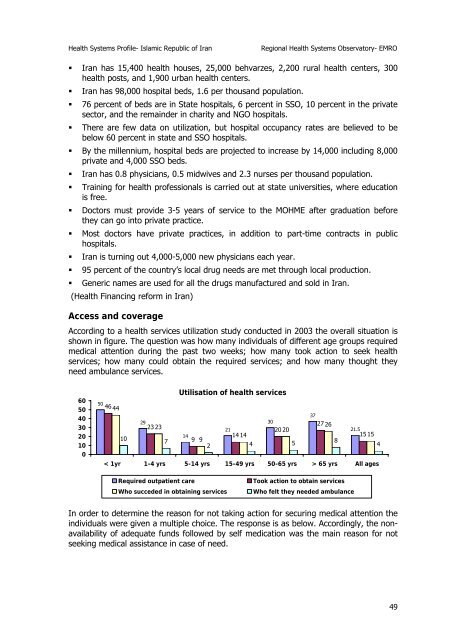Health system profile - Islamic Republic of Iran - What is GIS - World ...
Health system profile - Islamic Republic of Iran - What is GIS - World ...
Health system profile - Islamic Republic of Iran - What is GIS - World ...
You also want an ePaper? Increase the reach of your titles
YUMPU automatically turns print PDFs into web optimized ePapers that Google loves.
<strong>Health</strong> Systems Pr<strong>of</strong>ile- <strong>Islamic</strong> <strong>Republic</strong> <strong>of</strong> <strong>Iran</strong> Regional <strong>Health</strong> Systems Observatory- EMRO<br />
<strong>Iran</strong> has 15,400 health houses, 25,000 behvarzes, 2,200 rural health centers, 300<br />
health posts, and 1,900 urban health centers.<br />
<strong>Iran</strong> has 98,000 hospital beds, 1.6 per thousand population.<br />
76 percent <strong>of</strong> beds are in State hospitals, 6 percent in SSO, 10 percent in the private<br />
sector, and the remainder in charity and NGO hospitals.<br />
There are few data on utilization, but hospital occupancy rates are believed to be<br />
below 60 percent in state and SSO hospitals.<br />
By the millennium, hospital beds are projected to increase by 14,000 including 8,000<br />
private and 4,000 SSO beds.<br />
<strong>Iran</strong> has 0.8 physicians, 0.5 midwives and 2.3 nurses per thousand population.<br />
Training for health pr<strong>of</strong>essionals <strong>is</strong> carried out at state universities, where education<br />
<strong>is</strong> free.<br />
Doctors must provide 3-5 years <strong>of</strong> service to the MOHME after graduation before<br />
they can go into private practice.<br />
Most doctors have private practices, in addition to part-time contracts in public<br />
hospitals.<br />
<strong>Iran</strong> <strong>is</strong> turning out 4,000-5,000 new physicians each year.<br />
95 percent <strong>of</strong> the country’s local drug needs are met through local production.<br />
Generic names are used for all the drugs manufactured and sold in <strong>Iran</strong>.<br />
(<strong>Health</strong> Financing reform in <strong>Iran</strong>)<br />
Access and coverage<br />
According to a health services utilization study conducted in 2003 the overall situation <strong>is</strong><br />
shown in figure. The question was how many individuals <strong>of</strong> different age groups required<br />
medical attention during the past two weeks; how many took action to seek health<br />
services; how many could obtain the required services; and how many thought they<br />
need ambulance services.<br />
60<br />
50<br />
40<br />
30<br />
20<br />
10<br />
0<br />
50<br />
46 44<br />
10<br />
29<br />
23 23<br />
7<br />
Util<strong>is</strong>ation <strong>of</strong> health services<br />
14<br />
9<br />
9<br />
21<br />
14 14<br />
30<br />
20 20<br />
2 4 5<br />
37<br />
27 26<br />
8<br />
21.5<br />
15 15<br />
< 1yr 1-4 yrs 5-14 yrs 15-49 yrs 50-65 yrs > 65 yrs All ages<br />
Required outpatient care Took action to obtain services<br />
Who succeded in obtaining services Who felt they needed ambulance<br />
In order to determine the reason for not taking action for securing medical attention the<br />
individuals were given a multiple choice. The response <strong>is</strong> as below. Accordingly, the nonavailability<br />
<strong>of</strong> adequate funds followed by self medication was the main reason for not<br />
seeking medical ass<strong>is</strong>tance in case <strong>of</strong> need.<br />
4<br />
49

















